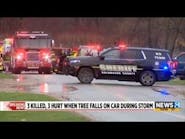On the day I am writing this, a person shot five people at a cafe near the University of Washington in Seattle and then shot himself in the head as police closed in on him. His rampage left three people dead and two critically wounded. Nobody knows why he did the shooting, but his family told police he had a history of mental problems.
Unfortunately, many of these cases where multiple people are shot occur in schools and colleges. But not all of them. The shooting of U.S. Representative Gabrielle Giffords and 18 other people outside a Tucson, AZ, supermarket parking lot one Saturday morning when she was hosting a town hall get-together proves that.
But we do seem to see a lot of mass shootings at places of education. I remember watching the live dramatic events unfold on CNN at Columbine High School in Littleton, CO, in 1999. Eric Harris and Dylan Klebold killed 12 students and a teacher, and injured 21 other students before taking their own lives.
Mass shootings usually fall into three different categories: rampage killers; workplace killers; and school shooters. All three of categories can be classified as active shooters.
The rampage killer is a spree killer who has shown no previous sign inclination to violence and acquires a weapon and in a sudden frenzy will attempt to kill or seriously injure anyone he encounters. Such was the case when a 19-year-old Robert Hawkins walked in a mall in Omaha, NE, in 2007 and starting shooting, resulting in eight dead and four wounded. Hawkins shot himself as police closed in.
The unfortunate phrase “going postal” came about in 1986 with a series of events involving U.S. Postal Service employees who walked into post offices and shot their supervisors and other employees. The term “going postal” is also associated with employees who shoot people at their places of employment. Such was the case in 2005, when a female postal employee walked into a post office and killed six fellow employees and then committed suicide.
One of the more noteworthy workplace shootings, or what some consider to be a terrorist attack, occurred when U.S. Army Major Nidal Hasan opened fire on a room of 600 people at Fort Hood in Texas, killing 13 and wounding 29. He was shot within three minutes by a police officer who had received active-shooter training.
The third type of active shooter is the school shooter, or someone who shoots people at an educational institution. Usually, this is a student who enters the school and shoots people at random. Since 1976, there have been more than 50 multiple-victim shootings at schools, with most of the shooters being students who were 21 or younger.
In the Columbine incident, planned for more than a year, Harris and Klebold set off a small firebomb in a field one mile from the school. The intent was to divert emergency personnel elsewhere. Going to the school, they placed two 20-pound propane bombs in duffel bags in the cafeteria. When the bombs detonated, killing students in the cafeteria, they planned on each covering a main entrance of the school and shooting students as they fled the building. When the bombs failed to detonate, they entered the school and shot students at random. Once firefighter/paramedics arrived and began treating victims on the lawn, they were fired on from school windows. Four firefighters came under fire as they carried wounded people to ambulances.
An active shooter is usually someone who has the intent to engage and shoot as many people as possible in the shortest period. In many cases, they pre-plan the operations, will be heavily armed and possibly armored, and will kill as many innocent people as possible until they are confronted by police. Usually, they will then commit suicide. For the most part, there is no negotiating with an active shooter and those who have been in their presence describe them as being a delirium state of mind.
Many police agencies have planned for active shooters. Their first goal is to announce their arrival and disrupt the person from continuing to fire. Their next goal is to engage the shooter as soon as possible with goal of neutralizing the shooter. Translated – they will shoot first and ask questions later.
Unfortunately, the first 911 calls will not accurately describe that a person is randomly shooting people. The first calls will be from someone who hears shots being fired or a report of someone shot. It is imperative that staging areas be used for any call related to any shooting – in fact, many other calls also including stabbings, domestic violence, assaults, etc. Only after the scene has been secured with the shooter(s) in custody or killed should fire and EMS personnel go into the scene. There will be those who want you to come in to the scene if there are injuries and it takes a while to secure the scene. However, you must resist the emotions of the moment and maintain your own security.
An active shooter in your community will challenge your fire and EMS deployment. By preparation, practice and then ultimately executing what you planned and practiced for with an active shooter, you can make sure we safeguard our people and handle the incident smoothly.
For more news and training on EMS, visit http://EMSWorld.com/.
GARY LUDWIG, MS, EMT-P, a Firehouse® contributing editor, is a deputy fire chief with the Memphis, TN, Fire Department. He is chair of the EMS Section for the International Association of Fire Chiefs (IAFC), was appointed to the National EMS Advisory Council by the U.S. Secretary of Transportation and is a member of the International Association of Fire Fighters (IAFF) EMS Standing Committee. Ludwig has a master’s degree in business and management and is a licensed paramedic. He can be reached at www.garyludwig.com.





